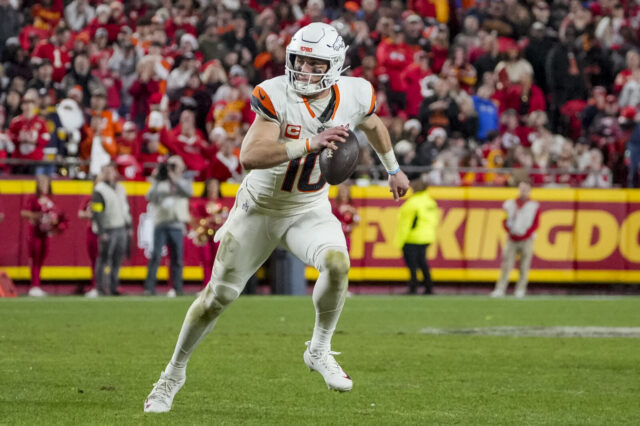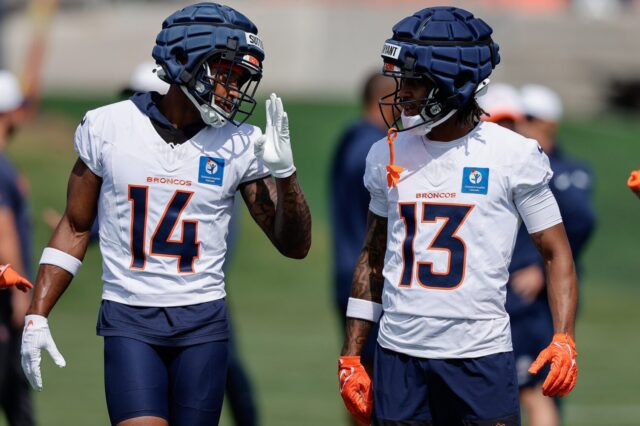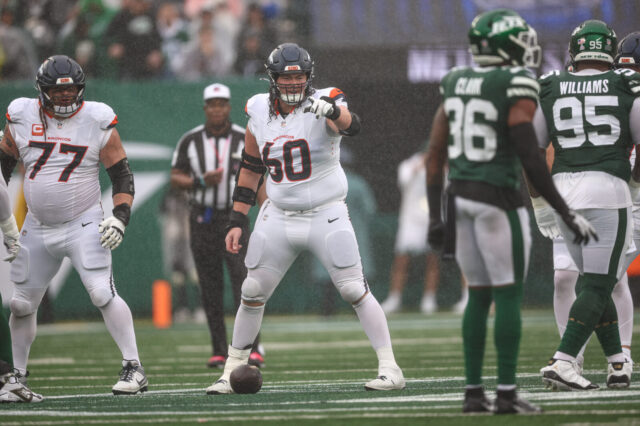In Denver, John Elway can do no wrong. The former Broncos quarterback is idolized in the Mile High City unlike few other athletes or celebrities.
No one remembers his faults as a player. No one questions his business ventures. No one is critical of his moves as the team’s general manager. And no one doubts that he’ll make all the right decisions to ensure the franchise’s success in the future. “In Elway We Trust” is a truism along the Front Range.
It’s also a complete sham, one that ignores history, doesn’t consider the facts and hinges on little more than blind faith. And it’s setting the Broncos and their fans up for a big-time fall.
At this very moment, the team is at a crossroads; they’re benching Peyton Manning in favor of Brock Osweiler, blaming a litany of injuries for the transition from a future Hall of Fame quarterback to one who has thrown less career passes (54) than Philip Rivers threw in Week 6 at Green Bay (65). And most people, from fans to the sheep-like media that cover the team, have no problem with the move.
On the surface, there’s plenty of evidence to suggest that a change is needed. Manning has struggled most of this season, throwing 17 interceptions and just nine touchdowns on the year. And this past Sunday against the Chiefs, he was downright awful, chucking four interceptions and posting a quarterback rating of 0.0. It’s hard to dispute numbers like that; they warrant being benched.
It’s also exactly what Elway wanted to have happen. It took nine weeks, but the GM finally gets to turn the page and play the quarterback he selected in the second round of the 2012 NFL Draft. On Nov. 22, the Broncos get to field the offense they’ve wanted since March.
Cut the X-Files music? Perhaps. But there’s a mountain of evidence to suggest what some will consider a crazy conspiracy theory.
It started last season when the Broncos changed their offense after a Week 11 loss to the Rams. Falling to 7-3 after the 22-7 setback, Denver scrapped Manning’s pass-happy, hurry-up attack; they shuffled their offensive line midstream and tried to become a more balanced offense.
In terms of wins and losses, the results weren’t bad; the Broncos went 5-1 in their final six games to finish with a 12-4 mark and earn the AFC’s No. 2 seed in the playoffs. But the quarterback’s numbers tanked. Through the first 10 games of the season, Manning threw 30 touchdowns and just nine interceptions. In the final six contests, No. 18 tossed only nine scores to six picks.
The handwriting was on the wall, as Elway was clearly letting his quarterback know that the days of running the fast-break offense were over in Denver. It’s why Manning hinted during a post-practice media session on Christmas Eve that he wasn’t sure the Broncos wanted him back in 2015, something he reiterated following the team’s loss to the Colts in the Divisional Playoffs.
But that was only the beginning. During the offseason, the signs that the team was ready to move on went from subtle to blinking in neon.
First, Elway hired his former teammate to be the team’s new head coach, bringing Gary Kubiak back to Denver to replace John Fox. That meant a permanent change in offensive scheme, moving to a run-first attack that used play-action passes to generate big plays. This would require Manning to play under center, roll out and do other things that aren’t well-suited for his current skillset.
That’s a tough transition to make when a player is entering his 18th season, but the quarterback gave it a shot. He joked about being able to run any system other than Delaware’s wing-T and spoke of being rejuvenated by the process of learning a new system. But anyone who watched Manning try to run Kubiak’s offense knew that it was like casting Sylvester Stallone to play Hamlet; it wasn’t going to work no matter how hard everyone involved tried to make the mismatch functional.
The nudges didn’t end there, however. In March, Elway asked Manning to take a $10 million pay cut, a ridiculous notion that would have made No. 18 the league’s 18th highest-paid quarterback in 2015; that makes no sense to anyone other than a numerologist. Clearly, the purpose was to push Manning toward retirement; the Broncos didn’t want to release him, but they surely wouldn’t have minded if the quarterback did the dirty work for them.
But Manning still wanted to play, so the two sides were at an impasse. This led Elway to explore trade possibilities, including one that would have sent the quarterback to Houston. The Broncos deny this rumor, but the fact that Manning’s agent requested a no-trade clause in a reworked contract that settled on a $4 million reduction in salary, something that wasn’t there during the player’s first three seasons in Denver, suggests there’s validity to the claim.
Regardless, the quarterback returned to the team, with both sides trying to play nice and say all of the right things. Beneath the surface, however, trouble was brewing. The Broncos were paying Manning, but they clearly weren’t committed to their quarterback. In a lot of ways, they were actually setting him up for failure.
When Elway was an aging quarterback chasing a championship in his final years as a player, the Broncos built a formidable offensive line in front of him, a group that could protect him on passing plays and open holes for a pressure-relieving running game. As the team’s general manager, he did just the opposite in for Manning.
This season, Denver has played nine different offensive linemen, eight of whom are currently rotating on a series-by-series basis during games. This isn’t because of injury; and it’s not due to an abundance of talent that needs to see the field. It’s because Elway has assembled one of the worst o-lines in team history.
Here’s how the nine is comprised: Two rookies (Ty Sambrailo and Max Garcia), two who had played zero career NFL snaps heading into 2015 (Matt Paradis and Michael Schofield), a journeyman street free agent that was signed during the offseason (Ryan Harris), a journeyman street free agent that was signed during the regular season (Tyler Polumbus), a former Pro Bowl guard that was added so late that he didn’t play in a single preseason game (Evan Mathis), and an All-Pro guard that is playing so poorly that he’s being relieved at times by Garcia (Louis Vasquez).
That’s the group that Elway assembled to protect a 39-year-old, immobile quarterback. If he isn’t guilty of setting Manning up for failure, then he’s certainly culpable of neglecting the team’s talent in the trenches. Given that he won back-to-back Super Bowls behind offensive lines that featured the likes of Gary Zimmerman, Brian Habib, Mark Schereth, Tony Jones, Harry Swayne and Tom Nalen, it seems unlikely that No. 7 didn’t understand the importance of a good o-line.
Of course, swinging and missing on tackles, guards and centers wouldn’t be the only examples of Elway failing to properly evaluate talent. He didn’t replace Wes Welker as the team’s third receiver during the offseason because he felt second-year wideout Cody Latimer was ready to step up; that hasn’t happened. And he seriously thought Owen Daniels was a suitable replacement for Julius Thomas, a mistake that created such a gaping hole at tight end that the Broncos felt compelled to trade for Vernon Davis midseason.
It all adds up to an offensive roster that is a shell of its former self. In 2013, Denver rode the greatest offense in NFL history all the way to Super Bowl XLVIII. During the 21 months since they were blown out by the Seahawks in that game, the Broncos have watched eight of the 11 starters from that team walk out the door. And for the most part, they’ve failed to adequately replace them.
That’s enough to make someone believe their employer isn’t giving them the tools necessary to succeed. Heck, Milton got more positive reinforcement in Office Space than Manning has received since leading the Broncos within one game of a championship.
And it’s created an atmosphere of distrust and paranoia. Manning doesn’t believe that the Broncos want him around, so he’s scared to death of leaving the field; he knows that they are looking for any possible reason to sit him down for good.
As a result, he was unwilling to sit out the game against Kansas City, despite the fact that he clearly wasn’t physically fit to play, and he’s been getting treatment for various ailments from people outside of the organization, not wanting to provide the team with any ammunition to justify keeping him out of the lineup. That’s not a healthy situation, by any stretch of the imagination.
But for eight games, it didn’t matter. The Broncos found a way to start the season 7-0, despite some often-sketchy play from their quarterback. And their first loss of the year, a 27-24 setback at Indianapolis, didn’t cause much panic, as the defeat was overshadowed by Aqib Talib’s eye-poking incident in the waning minutes of the game.
On Sunday, however, it all came to a head. The disaster that had been brewing for months finally exploded in everyone’s face. The Broncos offensive line couldn’t stop the Chiefs pass rush or open any holes for the running game. Manning made errant throws and bad decisions. And the team’s offense was as anemic as it’s perhaps ever been, leading to a quarterback change with Denver trailing 29-0.
It all adds up to the Broncos getting exactly what they want. They get to bench Manning without any public outcry, as the last image of the aging quarterback was such a feeble and ugly one. And they get to see what they have in Osweiler, a player who has dutifully bided his time for three-plus seasons as Manning’s backup. It’s the perfect scenario, bailing them out of a potentially awkward situation.
Meanwhile, No. 18 has no choice but to quietly take the demotion. After all, his performance against the Chiefs doesn’t leave much room for him to argue the move; the general consensus is that the future Hall of Fame quarterback simply can’t get it done any more, a perceived reality that provided the Broncos with few options in the minds of most onlookers.
Of course, that’s all based on simply looking at one set of facts. The naysayers focus simply on the bad moments, ugly throws and slipping statistics. But the season has been filled with some highlights. In fact, there have been flashes of greatness, plays that demonstrated something left in the QB’s tank.
Just nine days ago in the loss at Indianapolis, Manning led a Broncos rally in the second half by going 12-of-13 for 182 yards and two touchdowns before throwing an interception on his final pass of the game. In the process, he looked as nimble as ever, highlighted by a deep touchdown pass to Emmanuel Sanders that included some nifty footwork in the pocket by the 39-year-old quarterback.
But there weren’t enough of those plays to prevent the inevitable. At some point, a situation stacked against Manning was going to lead to the quarterback getting injured, playing poorly or both. And that’s exactly what has happened.
Now, the only question that remains is, how will this all end?
Whatever the outcome, the post-Manning era in Denver isn’t far away. And Elway’s talents as a general manager are about to be put to the test. During his four-plus years on the job, he’s 45-12 with No. 18 as his quarterback, and 8-8 when someone else is behind center. But based on the way he’s treated his legendary signal caller, it appears as though Elway believes he’s solely responsible for the 53-20 overall mark.
Everyone is about to find out. And the “In Elway We Trust” mantra will be put to the test. John Elway has what he wanted in March: Brock Osweiler is at the helm.



